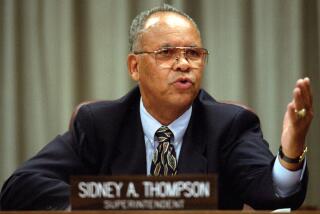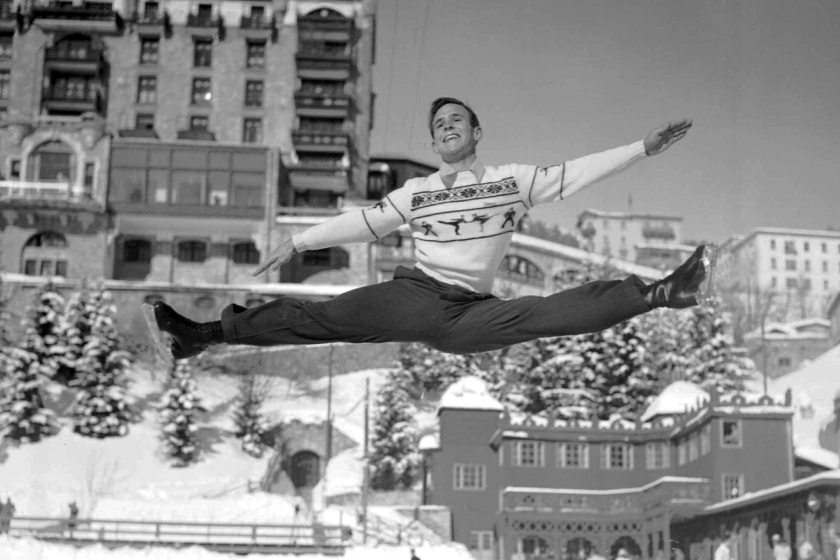A Matter of Spirit : Ground Broken at School Named for Olympic Hero Jim Thorpe
- Share via
SANTA ANA — The dusty field on West Alton Avenue was barren and blazing hot.
But the image of sports great Jim Thorpe stood triumphant over the 175 schoolchildren, educators and fans who gathered Wednesday to break ground for what is believed to be the first school in California named after the Native American who won two gold medals in the 1912 Olympic Games.
“Not everyone is geared to sports,” said Thorpe’s daughter, Grace, who was flown in from Oklahoma to give the James Francis Thorpe Elementary School keynote address. “But regardless of whatever your endeavor is, I hope dad’s spirit will be of great inspiration to you.”
Grace Thorpe, 75, carried with her a representation of a gold medal, slightly larger than a quarter, that her father won 85 years ago.
“If you touch it,” she said, “if you’re into athletics, it will do something for you.”
Officials say the number of Native Americans in the Santa Ana school district is small--only 16. But Trustee Robert W. Balen said the district, which is 90% Latino, wanted to promote diversity by naming a school after a Native American.
“He’s always been a personal hero of mine,” Balen said. “He captured my imagination.”
The school, slated for completion in January 1999 on a 6.6-acre site, will be distinguished by a central, circular building with classrooms radiating outward. It will cost about $13.1 million to build and serve 870 students.
The Olympic gold medals were among Thorpe’s greatest achievements. But they also brought controversy and, ultimately, bitterness.
After Thorpe’s pentathlon and decathlon victories in the games at Stockholm, Sweden’s King Gustav V declared, “You, sir, are the greatest athlete in the world.”
Seven months later, a Worchester, Mass., newspaper reported that Thorpe had earned $2 per game playing baseball before the Olympics, compromising his amateur status. The International Olympic Committee demanded that Thorpe return the medals. Thorpe honored the request, but had harsh feelings about it for the rest of his life.
In 1983, the committee returned replicas of the medals to Thorpe’s surviving family members.
The Santa Ana Unified School District was determined to bring Thorpe’s daughter to Orange County. The district solicited donations from local businesses to fly her out, put her up at a hotel and pay her a $2,000 speaker’s fee, said spokeswoman Christine Sanchez.
While Thorpe’s determination on the playing field and poise in private life were held out as an inspiration to all, local Native Americans took special pride in Thorpe’s ancestry.
“I’m a Jim Thorpe groupie,” said Costa Mesa resident and Cherokee Indian Gloria Bogdan, who met Thorpe while working in Hollywood. “He’s a hero to us Indians.”
Sonia Johnston, tribal chairwoman of the local Juaneno Band of Mission Indians, blessed the school site. She said Thorpe was a historical figure who could still “remind children of their capabilities.”
She added: “Jim Thorpe will always be a hero for all Indian people.”
Jim Thorpe grew up on the Sac and Fox Indian reservation in Oklahoma, although his ethnic background also included French and Irish blood. He died in 1953 in Los Angeles, where he had worked as a Hollywood casting agent.
Beside his Olympic victories, Thorpe’s resume included accomplishments on the baseball and football fields. More than a sports hero, he was also an inspiration to Native Americans, as indicated by the many tribal representatives at the groundbreaking.
Thorpe’s daughter said her father did not go beyond high school but frequently spoke to students, and understood the value of education. She said the elementary school was a fitting tribute.
“I am happy that his spirit is going to survive here in the school through children,” she said.
More to Read
Go beyond the scoreboard
Get the latest on L.A.'s teams in the daily Sports Report newsletter.
You may occasionally receive promotional content from the Los Angeles Times.






